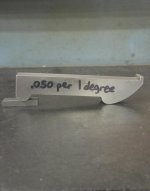For those who may be curious as to how I arrived at the above procedure, here are the drawings I made while contimplating it. First, this is a base drawing showing the sine bar in a 0° position:
I had to guess at the scale so it shows a 5" sine bar; that is 5" between the points of contact at the 0° position. Just as a first guess I put in a circular arc for the mystery curve. I also added two "dots", one at the origin which is the first point of contact and the other at +5, 0 coordinates which is the second point of contact. (I apologize for these dots not showing up in the first drawing above, they seemed to disappear when the drawing was converted to a .bmp file. You can see them in the second drawing below.) The sine bar is at zero degrees.
I have included a "solid" for it to rest on and have labeled the coordinates with conventional X-Y labels and added an "O" designation for the origin.
Then I made a second drawing, well a second layer in the same one. Here I wanted to have a big, easily visible difference so I choose a 20 degree angle for the orientation of the sine bar. You can see how I added that line 20° in the first drawing and it's position and orientation does not change here.
I wanted to keep the left hand point of contact at the same X coordinate so it is still directly above the origin of the X-Y coordinates. After some experiment I found that I had to raise it almost 2" to keep the mystery curve above the top of the surface it is resting on in drawing 1. So I raised it a full 2" (rough guess) and then rotated it by -20 degrees about the center of the left hand circle (X-Y coordinates 0,2). The position of the original 20 degree line is unchanged. I also erased the temporary arc that approximated the mystery curve so it would not confuse the issue. The dot at coordinates 5,0 is also still present and unmoved from the first drawing.
The right hand circle plainly is above the supporting surface. It is also obvious that we need a new point of contact that would be somewhere on the top of that supporting surface. What is not obvious is where on that surface it should be.
While contemplating this situation I imagined doing the same operation for different angles and different elevations at the left side. In each of these different positions the location of the needed support point would be defined by the top of the supporting surface. So I could take the same depiction of the sine bar and rotate/elevate by the various increments and add a short line segment along the top surface of the supporting surface to it. That collection of line segments could be truncated at their intersection points and I would have an approximation of the desired mystery curve.
And then It hit me that the above operations, rotation and elevation, could be easily be performed on a milling machine with a RT. Cut along X axis, rotate by an increment, move along Y axis by an increment, repeat. Bingo! There's your curve.
No proper name. No math beyond adding the increments. And it generates your desired, mystery curve. I would be willing to bet that is how the one in the photo was made.
I do not have a mathematical proof that these line segments will not interfere with each other. Nor do I have any proof that they are an optimal solution for this problem. But I do suspect that they do meet both of these criteria.


